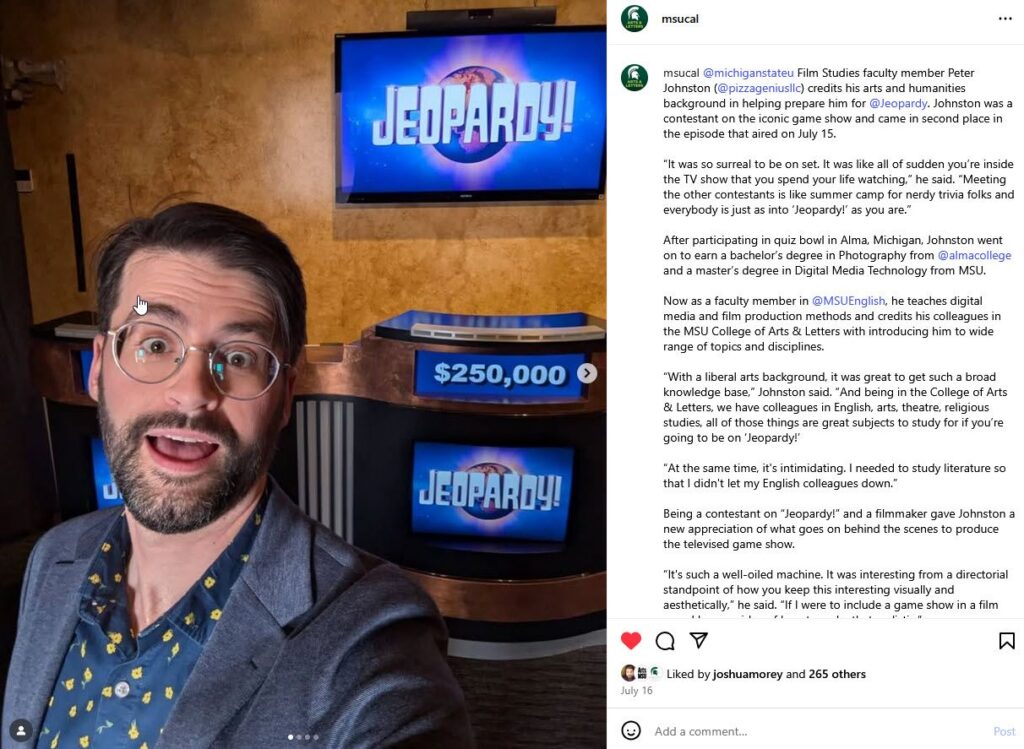Departments, programs, centers and other units in the College of Arts & Letters may want to use social media to to promote events, share awards and accolades, and engage with students, prospective students, faculty, and alumni.
Before Starting a New Social Account
If you’re part of the College of Arts & Letters and are thinking about starting a new social media account, contact Beth Bonsall. She can help discuss different strategies and social channels based on your goals, as well as ways to plan and sustain social posting and engagement.
We can help you think through what you want to communicate and accomplish through a social media channel and develop a plan for creating and posting different types of content on an ongoing basis. We can answer questions and share tips and tricks for different social media channels, as well as for growing an audience of followers to a new account.
We’ll also add you to the list of social account contacts in the College of Arts & Letters as a way to share resources, trends, and updates.
Reviewing Your Current Social Accounts
Audit your social accounts annually. Look at post engagement and social insights quarterly to determine what content is most popular with your followers.
It’s not necessary to have a social media account or profile on every platform. Some social channels may work better for your needs and the audience you want to reach than other channels.
Each social media platform has different nuances. The sizes for visual content vary by social media platform and also change continually. Hootsuite annually shares the optimal social media image sizes for photos and graphics based on the platform.
Maintaining an active social media account takes time. An active social media account will have a consistent flow of posts and interactions. You’ll want to consider the resources you have to:
- Plan, find, and develop social content.
- Post social content.
- Monitor your social content and followers (e.g., direct messages, comments, tagging, likes).
- Engage with your followers and their content directly.
- Plan and grow your followers.
College of Arts & Letters departments can contact Beth Bonsall for assistance in assessing your audience, goals, and content marketing needs. The Communications & Marketing Team can also help in creating an icon or choosing a banner photo for your social media pages.
Engagement & Commenting
Social media platforms encourage meaningful interaction with your audiences, and can help you build important connections and a sense of community.
Consistent social media engagement also increases the likelihood your posts will be favored by social media algorithms that control which posts are shown to your followers.

Some ways to engage with other social media accounts:
- Tag the College of Arts & Letters’ account on a post, photo, or video.
- Tag other related people and organizations on a post, photo, or video.
- Credit the photographer or contributor of a photo you post.
- Tag an organization directly in the text of a post.
- Use location tagging (when available) on a post.
- Reply to comments on your posts and any direct messages (and promptly within 24-72 hours if possible).
- Like and comment on your followers’ posts.
If an account directly mentions, tags, or shares your post, they are showing interest in your content, so continue to engage and interact with them.
Reposting User Generated Content (UGC) is another way to build community. UGC is content created by your audience members or followers that is reposted, after asking for permission, from your account. UGC often performs well and provides a way to be more authentic and inclusive.

Negative Comments
As a public institution committed to free speech, we are not allowed to delete comments we don’t agree with. There are some situations where deleting a comment is allowed. In some cases, hiding a comment may make sense. If you have questions, contact Beth Bonsall.
Sometimes social media accounts receive negative feedback and comments. If there is a post, comment, or message that brings criticism from another user, respond in a professional and appropriate manner that is solution-oriented and avoids accusatory and defensive language. To the best of your ability, your brand should respond with an explanation and a solution if possible.
Hashtags
Sometimes hashtag usage can help tap into existing conversations and audiences for monitoring and information discovery. Hashtags have becaome less effective as social media channels have updated search features, suggested content, and social algorithms. Hashtags should be used sparingly if at all.
When using hashtags, capitalize the first letter of each work for easier readability and accessibility (e.g., #SpartansWill).
MSU has a set of hashtags they use with regularity that may make sense to use in some social media posts, including:
- #SpartansWill for MSU aspirational brand-aligned content
- #GoGreen for athletics and sustainability
- #GlobalSpartans connected with education/study abroad programs, especially photos
More: Best Practices for Hashtags
Plan for Accessibility
While photos, graphics, and videos are important on social media channels, so is accessibility.
- Photos, graphics, and illustrations need to include alternative text (alt text). Alt text should describe what is pictured, including any text that may be part of a graphic or illustration.
- Any text on a graphic or illustration should be minimal for clarity and readability on mobile screens. Text should also be a part of the alt text for that graphic or illustration.
- Make sure the color contrast is high between text and image or graphic backgrounds.
- Videos should have burned in captions, auto-captioning through the social channel (that you review/edit before posting), or a caption file (SRT file) loaded with the video depending on the social platform capabilities.
Additional Accessibility Resources
- MSU Web Access: Creating Accessible Digital Content
- MSU Social Media Team: Social Media Accessibility Best Practices
- MSU Social Media Team: MSU Accessibility on Social Media Workshop Recording (YouTube)
- External: Accessible Social